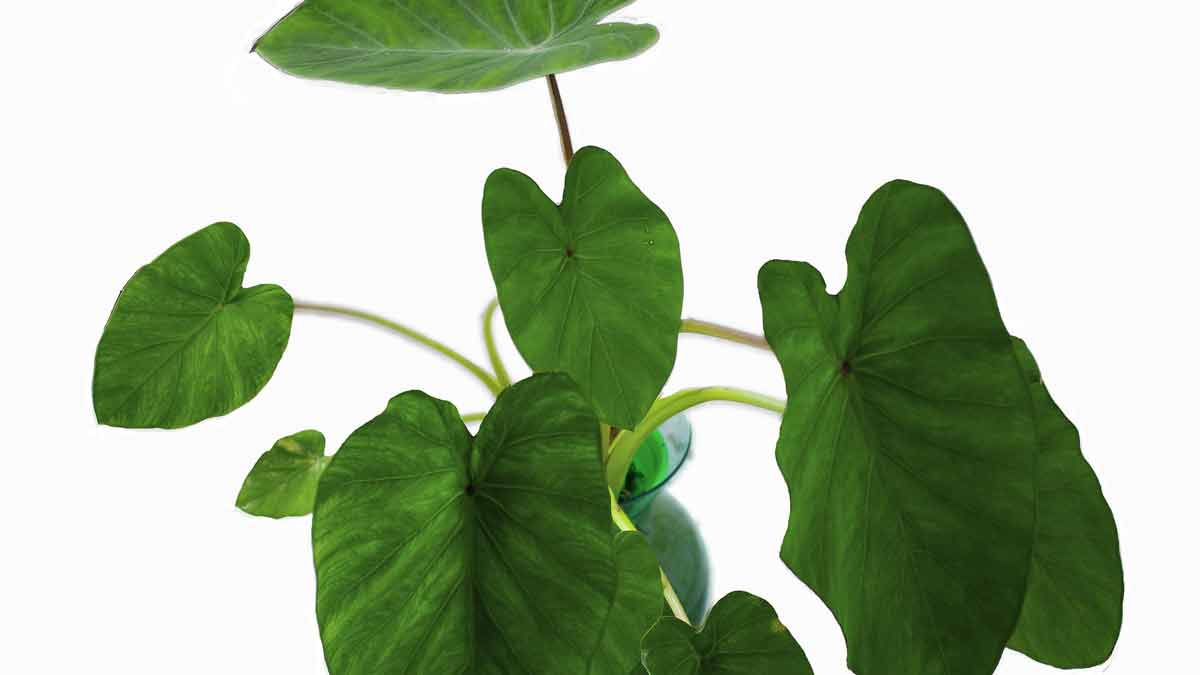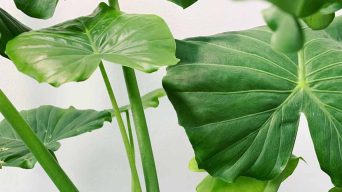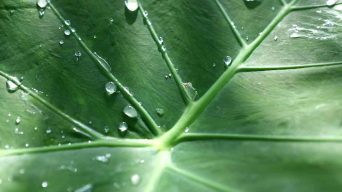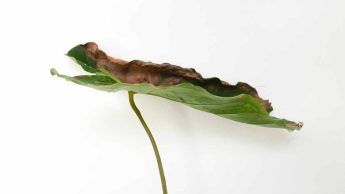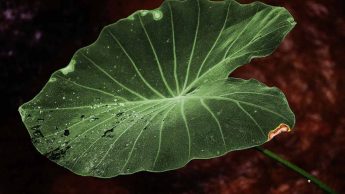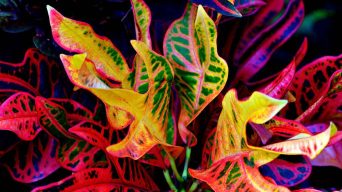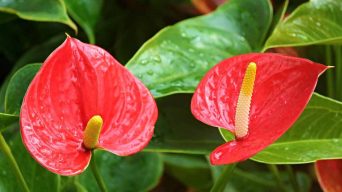Elephant ear plants are a type of tropical plant that is known for their large, heart-shaped leaves.
They are popular houseplants and are often grown outdoors in warm climates.
Elephant ear plants are relatively easy to care for but can sometimes experience problems.
If your elephant ear plant is dying, it is essential to identify the cause of the problem so that you can take steps to correct it.
This article will discuss 11 possible causes of a dying elephant ear plant and provide solutions for each one.
Why Is My Elephant Ear Plant Dying?
To save a dying elephant ear plant, it is crucial to identify the cause of the problem.
There are several potential causes of death in elephant ear plants, and each one requires a different solution.
The following are 11 possible causes of a dying elephant ear plant:
1. Overwatering
One of elephant ear plants’ most common causes of death is overwatering.
Elephant ear plants are native to tropical climates and cannot tolerate excessive amounts of water.
When an elephant ear plant is overwatered, the roots cannot access the oxygen they need to function properly.
This can lead to root rot, which can eventually kill the plant.
How To Tell if You Are Overwatering Your Elephant Ear Plant
There are several signs that you may be overwatering your elephant ear plant.
- The leaves turn yellow or brown
- The leaves begin to drop off
- The plant looks wilted
- The stem is soft or mushy
- The soil is constantly wet or soggy
If you notice any of these signs, reducing the amount of water you are giving your plant is essential.
How To Save an Overwatered Elephant Ear Plant
If you believe your elephant ear plant is dying from overwatering, the first step is to stop watering it.
Allow the soil to dry out completely before giving your plant more water.
Once the soil is dry, you can begin watering your plant again, but be sure to water it less frequently than before.
An elephant ear plant needs only to be watered once every 7-10 days and even less often during the winter.
You also need to check the roots of your plant to see if they have been damaged by the overwatering.
If the roots are soft or mushy, you may need to trim them back to healthy tissue and repot your plant in fresh soil.
2. Underwatering
Underwatering is another common cause of death in elephant ear plants.
While these plants are tolerant of periods of drought, they will eventually begin to die if they do not receive enough water.
When the elephant ear plant is underwatered, the leaves will begin to droop, and the plant will look wilted.
If the problem is not corrected, the leaves will eventually turn yellow or brown and begin to fall off.
How To Tell if You Are Underwatering Your Elephant Ear Plant
There are several signs that you may be underwatering your elephant ear plant.
- The leaves turn yellow or brown
- The leaves start to droop
- The leaves begin to drop off
- The plant looks wilted
- The soil is dry and crumbly
- The growth is stunted
If you notice any of these signs, it is essential to take steps to increase the amount of water you are giving your plant.
How To Save an Underwatered Elephant Ear Plant
If you believe your elephant ear plant is dying from underwatering, give it a good watering.
Water the plant until the soil is saturated and water begins to run out of the drainage holes in the pot.
Allow the plant to drain thoroughly before putting it back in its place.
Once you have watered your plant, check the soil regularly to ensure it does not dry out.
Elephant ear plants need to be kept in moist soil at all times.
3. Not Enough Sunlight
Elephant ear plants need a lot of sunlight to thrive.
They need at least six hours of sunlight each day.
If an elephant ear plant does not receive enough sunlight, it will begin to stretch and become leggy.
The leaves will also be smaller than they should be.
If the problem is not corrected, the plant will eventually stop growing and begin to die.
How To Tell if Your Elephant Ear Plant is Not Getting Enough Sunlight
Several signs indicate your elephant ear plant is not getting enough sunlight.
- The plant stretches and becomes leggy
- The leaves are small
- The plant stops growing
- The leaves turn pale green or yellow
- The plant leans toward the light
If you notice any of these signs, it is essential to increase the amount of sunlight your plant receives.
How To Save an Elephant Ear Plant that is Not Getting Enough Sunlight
If you believe your elephant ear plant is not getting enough sunlight, move it to a location that receives more sunlight.
An east- or west-facing window is a good option. This will give your plant the six hours of sunlight it needs each day.
If you cannot move your plant to a location that receives more sunlight, you may need to supplement the natural light with artificial light.
4. Too Much Sunlight
While elephant ear plants need a lot of sunlight to thrive, they can also be killed by too much sun.
If an elephant ear plant is in harsh direct sunlight for too long, especially during the hottest hours of the day, the leaves will begin to scorch.
The edges of the leaves will turn brown and crispy.
If the problem is not corrected, the plant will eventually die.
How To Tell if Your Elephant Ear Plant is Getting Too Much Sunlight
Several signs indicate that your elephant ear plant is getting too much sunlight.
- The leaves begin to scorch
- The edges of the leaves turn brown and crispy
- The leaves start to droop
- Brown patches appear on the leaves
- The plant stops growing
If you notice any of these signs, it is essential to reduce the amount of sunlight your plant receives.
How To Save an Elephant Ear Plant that is Getting Too Much Sunlight
If you believe your elephant ear plant is getting too much sunlight, move it to a location that receives less sunlight.
A north- or east-facing window is a good option. This will help reduce the amount of direct sunlight your plant receives daily.
Elephant ear plants need bright indirect light to thrive, so be sure not to place them in a too shady location.
5. Nutrient Deficiency
Elephant ear plants need a balance of nutrients to thrive.
If they do not receive the essential nutrients, they will begin to die.
Elephant ear plants’ most common nutrient deficiencies are nitrogen, phosphorus, and potassium.
How To Tell if Your Elephant Ear Plant Has a Nutrient Deficiency
There are several signs that your elephant ear plant has a nutrient deficiency.
- The leaves are small
- The leaves are pale green or yellow
- The leaves curl or twist
- The plant stops growing
If you notice any of these signs, it is essential to take steps to correct the nutrient deficiency.
How To Save an Elephant Ear Plant with a Nutrient Deficiency
If you believe your elephant ear plant has a nutrient deficiency, fertilize it with a balanced fertilizer.
Elephant ear plants are heavy feeders, so they must be fertilized every two weeks during the growing season.
You can also add compost to the soil around your plant to help improve the nutrient content.
6. Overfertilization
While elephant ear plants need a lot of fertilizer to thrive, they can also be killed by too much fertilizer.
If an elephant ear plant is overfertilized, the roots will be damaged. This will cause the plant to become stressed and eventually die.
You can overfertilize your plant in two ways: by using too much fertilizer or by fertilizing too often.
How To Tell if Your Elephant Ear Plant is Overfertilized
There are several signs that your elephant ear plant is overfertilized.
- Brown leaf tips
- Yellow leaves
- Leaves falling off
- Brown or black roots
- Stunted growth
If you notice any of these signs, reducing the amount of fertilizer your plant is receiving is important.
How To Save an Elephant Ear Plant that is Overfertilized
If you believe your elephant ear plant is overfertilized, leach the soil with water.
To do this, water your plant heavily until water runs out of the drainage holes in the bottom of the pot.
Repeat this process several times to remove the excess fertilizer from the soil.
You will also need to reduce the amount of fertilizer you are using.
Fertilize your plant every four weeks instead of every two weeks.
7. Root-Bound
If an elephant ear plant is left in a too small pot, it will become root-bound.
This means the roots have filled the pot and are growing out of the drainage holes.
Root-bound plants cannot take up enough water and nutrients to thrive.
As a result, they will begin to die.
How To Tell if Your Elephant Ear Plant is Root-Bound
There are several signs that your elephant ear plant is root-bound.
- The roots are coming out of the drainage holes
- The roots are wrapped around the inside of the pot
- The plant is not growing
- The leaves are wilting
- The lower leaves are turning yellow or brown
If you notice any of these signs, it is important to take steps to replant your plant in a larger pot.
How To Save an Elephant Ear Plant that is Root-Bound
If you believe your elephant ear plant is root-bound, replant it in a pot two sizes larger.
You will also need to loosen the roots before replanting.
To do this, gently remove the plant from the pot and loosen the roots with your fingers.
You may need to trim the roots if they are too long.
Once the roots are loosened, replant your plant in the larger pot.
8. Poor Drainage
The roots will become waterlogged if an elephant ear plant is kept in soil that does not drain well.
Elephant ear plants need well-drained potting soil to thrive. If the roots are waterlogged, they will begin to rot.
This will cause the plant to become stressed and eventually die.
How To Tell if Your Elephant Ear Plant has Poor Drainage
There are several signs that your elephant ear plant has poor drainage.
- The leaves are wilting and drooping
- The leaves are turning yellow or brown
- The plant is not growing
- Mushy roots
If you notice any of these signs, it is important to take steps to improve the soil’s drainage.
How To Save an Elephant Ear Plant with Poor Drainage
If you believe your elephant ear plant has poor drainage, replant it in a pot with well-drained soil.
They need a potting mix that is high in organic matter.
You can also improve the drainage of your existing pot by adding sand or gravel to the bottom of the pot.
Ensure that the pot has drainage holes to allow the water to drain out.
9. Temperature Stress
If an elephant ear plant is exposed to temperatures outside its comfort range, it will become stressed.
This can cause the elephant ear leaves to droop, to turn yellow or brown, and eventually die.
Elephant ear plants are tropical plants and prefer warm temperatures.
However, they can also not tolerate temperatures that are too hot.
The ideal temperature range for elephant ear plants is between 60 and 85 degrees Fahrenheit.
How To Tell if Your Elephant Ear Plant is Stressed by Temperature
There are several signs that your elephant ear plant is stressed by temperature.
- The leaves are wilting and drooping
- The leaves are turning yellow or brown
- The leaves are falling off
- The plant becomes mushy and black
If you notice any of these signs, it is important to take steps to improve the temperature around your plant.
How To Save an Elephant Ear Plant that is Stressed by Temperature
If you believe your elephant ear plant is stressed by temperature, move it to an area with temperatures within its comfort range.
When the temperature outside is too hot, move your plant indoors.
Place it near a window where it can get bright indirect sunlight.
You can also use a fan to circulate the air around the plant and help cool it down.
When the temperature outside is too cold, move your plant to a warmer location.
You can also use a heat lamp to raise the temperature around the plant.
10. Pest Infestation
It will become stressed if an elephant plant is infested with pests. This can cause the leaves to turn yellow or brown and eventually die.
The most common pests that infest elephant ear plants are aphids, mealybugs, scale insects, spider mites, and whiteflies.
These pests suck the sap from the plant, which can cause it to become sick.
How To Tell if Your Elephant Ear Plant is Infested with Pests
There are several signs that your elephant ear plant is infested with pests.
- The leaves are wilting and drooping
- The leaves are covered in a sticky substance
- The leaves are turning yellow or brown
- The plant is not growing
- The plant has holes in the leaves
- The plant is covered in webbing
If you notice any of these signs, it is important to take steps to remove the pests from your plant.
How To Save an Elephant Ear Plant that is Infested with Pests
If you believe your elephant ear plant is infested with pests, you first need to isolate the plant from other plants.
This will prevent the pests from spreading.
Next, you need to remove the pests from the plant.
You can do this by hosing down the plant with water or removing the pests by hand.
To do this, use a cotton swab dipped in rubbing alcohol and rub it on the pests.
You can also use insecticidal soap or neem oil to kill the pests. These products are safe for use on plants and will not harm people or animals.
11. Diseases
Several diseases can affect elephant ear plants. These diseases can cause the leaves to turn yellow or brown and eventually die.
The most common diseases that affect elephant ear plants are anthracnose, root rot, and rust.
These diseases are caused by fungi and can be spread by water, wind, or insects.
How To Tell if Your Elephant Ear Plant has a Disease
There are several signs that your elephant ear plant has a disease.
- The leaves are wilting and drooping
- The leaves are turning yellow or brown
- The leaves have brown spots or blotches
- The leaves are covered in a powdery substance
- The plant is not growing
If you notice any of these signs, it is important to take steps to treat the disease.
How To Save an Elephant Ear Plant that has a Disease
If you believe your elephant ear plant has a disease, you first need to isolate the plant from other plants.
This will prevent the disease from spreading.
Next, you need to treat the plant with a fungicide.
This will kill the fungi that are causing the disease.
It is essential to follow the directions on the fungicide package and only use products that are safe to use on plants.
Final Thoughts
If your elephant ear plant is dying, it is essential to take steps to save it.
The first step is to identify the cause of the problem.
Once you have identified the cause, you can take steps to fix the problem and save your plant.
The most common causes of an elephant ear plant dying are too much or too little water, too much or too little sunlight, and pests or diseases.
If you take steps to fix these problems, you should be able to save your plant.

